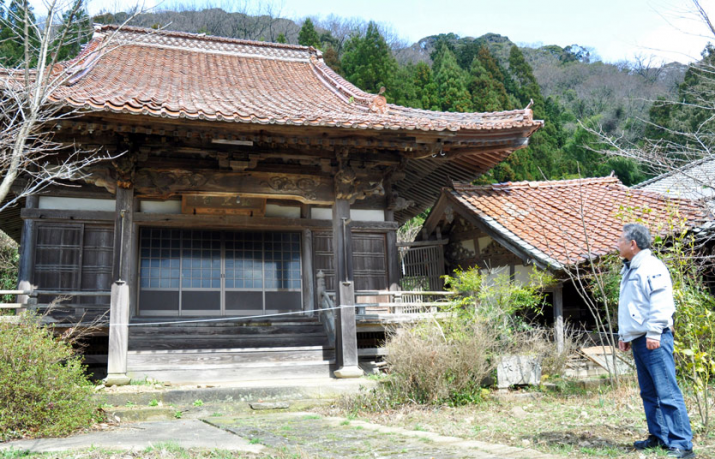NEWS
Survey Reveals Over 12,000 Temples in Japan Lack Resident Monks
 Konno-ji, a temple of the Jodo school of Pure Land Buddhism in Ota, Shimane Prefecture, recently closed down. From ajw.asahi.com
Konno-ji, a temple of the Jodo school of Pure Land Buddhism in Ota, Shimane Prefecture, recently closed down. From ajw.asahi.comA recent survey carried out by The Asahi Shimbun newspaper showed that 12,065 Buddhist temples in Japan are without resident monks, representing 16 per cent of temples affiliated with the 10 most popular schools of Buddhism in the country. The survey also found that 434 temples from 9 major denominations have closed completely in the past decade.
Temples in rural parts of Japan are struggling to maintain attendance and find successor monks as populations in these areas rapidly age and shrink. The ageing of Japan’s population is thought to outpace that of any other nation, based on data from Japan’s Statistics Bureau—as of September 2014, 33 per cent was aged over 60, while almost 26 per cent was aged 65 or above.
Temples associated with the 10 most popular schools—which include the Jodo, Jodo Shinshu, Nichiren, Shingon, Soto, Rinzai, and Tendai schools—account for about 80 per cent of Japan’s 75,900 Buddhist temples, according to 2014 data from Japan’s Cultural Affairs Agency. The Nichiren school declined to release the number of affiliated temples that had no resident monks, the survey said.
“Buddhist temples still remain as the centers of many local communities, and their demise would likely diminish ties among residents,” said Zaitetsu Nakamura, director of the Jodo school’s general affairs department. “It is the most significant problem for the Buddhism schools [in Japan] today.” (The Asahi Shimbun) Jodo Buddhism, or Jodo-shu, is a branch of Pure Land Buddhism established in 1175. Along with the Jodo Shinshu branch of Pure Land, it is the most widely practiced form of Buddhism in Japan.
The survey results suggest that the lack of monks could exacerbate the demise of these traditional community focal points and make it difficult for members of small communities to maintain the graves of family members and to perform memorial rituals. Of the 12,065 temples without resident monks, 10,496 are managed and maintained by what the survey described as “non-resident chief monks” from other temples. The remaining 1,569 temples have no non-resident chief monastic officer. Unstaffed temples are usually eventually merged with other temples or closed down.
“Temples in under-populated areas tend to have the least revenue, and the Buddhism schools have found it increasingly difficult to financially support their operations,” said Soko Kushi, an adviser to the Myoshin-ji school’s department that is in charge of promoting revitalization efforts. “Retired residents, who have retirement benefits, income from pensions, and other financial assets, should be encouraged to lead efforts to preserve temples in their communities.” (The Asahi Shimbun)
Since 2012, the Myoshin-ji branch of the Rinzai school has recruited retired lay people to undergo training and serve as resident monks for unstaffed temples. So far more than 20 retirees have participated in the initiative. Myoshin-ji is the largest branch of Rinzai Zen—roughly as big as the other 13 branches combined—and accounts for about 3,500 temples in Japan.
Toshinori Kawamata, a professor of religious sociology at Suzuka Junior College in Mie Prefecture, said that Buddhist schools in Japan should re-examine the prevailing hereditary system at temples—many monastic orders in Japan allow monks to marry and raise families, which has resulted in the spread of hereditary succession practices at many temples.
Kawamata said a new system was needed that would allow young monks who have just completed training to be dispatched to vacant temples so that they could continue to operate as community centers.
See more
Survey: 12,000 Buddhist temples lack resident monks (The Asahi Shimbun)
Population Estimates by Age (5-Year Age Group) and Sex (Statistics Bureau)














